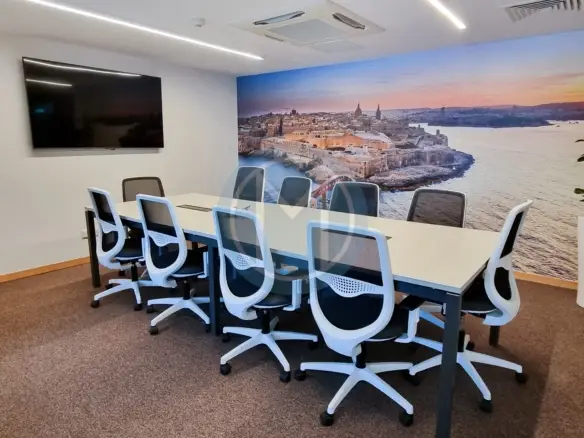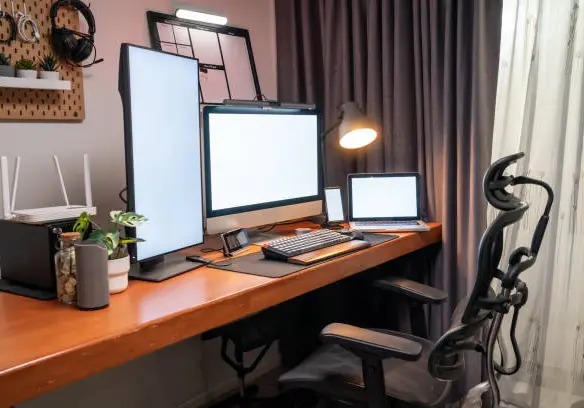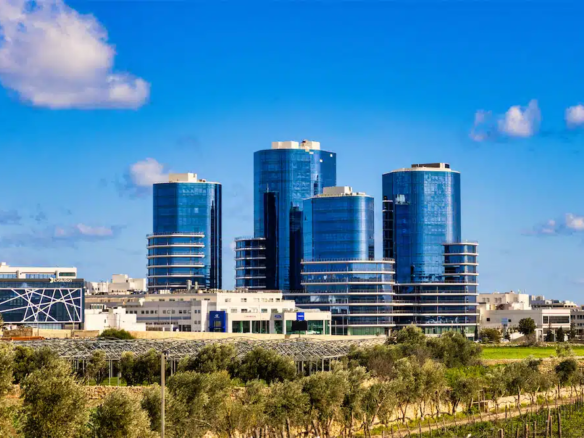An open-plan office in Malta? Things to consider.
 It’s likely that the concept of the open-plan office in Malta was first inspired after it’s launch in Germany way back in the 50s; the idea was to ease communication and collaboration between employees by breaking down walls that act as “barriers to success”. Nowadays, numerous organisations the world over have chosen to adopt this layout for their businesses; apart from enhancing communication, it is also considered modern and stylish.
It’s likely that the concept of the open-plan office in Malta was first inspired after it’s launch in Germany way back in the 50s; the idea was to ease communication and collaboration between employees by breaking down walls that act as “barriers to success”. Nowadays, numerous organisations the world over have chosen to adopt this layout for their businesses; apart from enhancing communication, it is also considered modern and stylish.
Both research findings, as well as individual business leaders, have attested to a boost in performance through the shift to this layout.
An Open layout will allow for Easy Interaction.
The absence of physical walls in an open plan office was to make it simpler for colleagues to communicate with each other. This, in turn, leads to easier workflow and fewer misunderstandings since co-workers can regularly revert back to each other when working in close quarters.
Team Spirit increases in an Open plan office.
The constant communication encouraged in open-plan layouts tends to foster an increased sense of togetherness amongst co-workers since they report feeling more like they are working towards a common goal. This sense of team spirit facilitates greater collaboration and even conflict resolution so your organisation is bound to benefit from a more coherent workforce.
Open areas offer reduced costs.
One of the major pros of open offices is that organisations are likely to benefit economically due to reduced costs of office equipment, construction and utilities. Fewer walls make your office space more accommodating to a larger number of employees and the shared communal resources mean that you get to redirect your business’s finances to other areas.
Nevertheless, despite the various benefits an open plan layout can bring to your organisation, it can also just as easily hinder productivity in some cases. Unfortunately, not all employees are programmed to work one specific way, however, and this crucial point is oven overlooked when organisations choose to conform to an open-plan layout.
Distractions may increase in an Open Plan Office.
 Open plan layouts inevitably force people to work together in a common area with little to no privacy. This can prove a nuisance for some who find that they work better without distractions. Hearing employees coming and going, conversing, phones ringing and even music playing from colleague’s laptop is enough to disrupt any individual’s thought process and concentration levels.
Open plan layouts inevitably force people to work together in a common area with little to no privacy. This can prove a nuisance for some who find that they work better without distractions. Hearing employees coming and going, conversing, phones ringing and even music playing from colleague’s laptop is enough to disrupt any individual’s thought process and concentration levels.
Moreover, open-plan offices have also done away with the hierarchy of traditional offices where employees are positioned according to their ranking within the company. Instead, employees are grouped according to projects rather than departments and this has been found to greatly enhance workflow.
Open-plan offices suffer from lack of Privacy.
 Apart from the various visual and acoustic distractions employees in open-plan offices have to endure, there’s also the concern of a decrease in a confidential communication, making it harder for colleagues to communicate effectively with one another without fear of being overheard. Recently, this has led to many opting to transfer their in-office conversations to an online platform like Skype instead. While this is an effective alternative, it may take away from some of the strengths of face-to-face communication.
Apart from the various visual and acoustic distractions employees in open-plan offices have to endure, there’s also the concern of a decrease in a confidential communication, making it harder for colleagues to communicate effectively with one another without fear of being overheard. Recently, this has led to many opting to transfer their in-office conversations to an online platform like Skype instead. While this is an effective alternative, it may take away from some of the strengths of face-to-face communication.
The spread of Germs is easier in open spaces.
While you may unlikely to catch smallpox from your co-worker, research shows that open-plan offices do increase the spread of germs and illnesses due to shared spaces. This could mean more sick leave since one employee who comes to work with a bad cold is likely to infect those working close to him.
Minimising Distractions in Open Plan Offices.
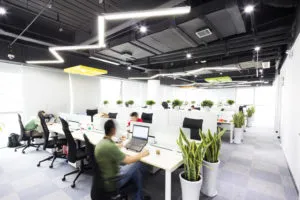 While open-plan offices have undoubtedly transformed the way organisations operate over the past 50 years, it’s also worth considering that no two companies are the same so while this layout may work for some, it may not be ideal for others. When considering office layout, think about the size and scope of your workforce before simply going for open plan automatically. The Living Office, launched by Herman Miller, for example, mitigates these crucial aspects of an organisation and caters accordingly.
While open-plan offices have undoubtedly transformed the way organisations operate over the past 50 years, it’s also worth considering that no two companies are the same so while this layout may work for some, it may not be ideal for others. When considering office layout, think about the size and scope of your workforce before simply going for open plan automatically. The Living Office, launched by Herman Miller, for example, mitigates these crucial aspects of an organisation and caters accordingly.
While the open office layout was intended to break down barriers between co-workers and encourage communication and collaboration, it doesn’t come without its disadvantages.
There’s no denying that capitalising on space and resources, fostering informal interactions and aiding workflow have been some of the major benefits that popularised the open layout. However, this increase in communication has also correlated with a surge in distractions, and in turn lower levels of productivity in some cases.
Some employees may thrive off working closely with others but others may be more apt at working alone; the latter type may have come to despise their open office layout and yearn for private cubicles where they can get their work done in peace.
Fortunately, there are some measures you can take to cater for co-workers who feel disrupted in office open spaces without having to undertake a complete overhaul of your office layout.
Give them Some Alone Time.
By dedicating an area of the office to drop-in workstations where no interruptions are allowed, so employees can make use of them when working on a tight deadline or a laborious task that requires high levels of concentration. Moreover, permit the use of meeting or conference rooms for this same purpose and clarify the fact that it’s permissible or even encouraged employees to work away from their desks sometimes.
Allow More Control.
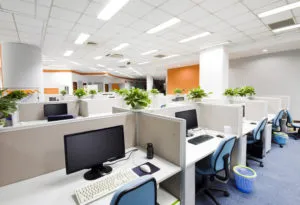 Allow your staff to control all aspects of these private workstations, as they wouldn’t be able to when sitting at their desk in the open office area. Introduce speakers and desk lamps to adjust acoustics and lighting for example. Additionally, allow them to also limit technological distractions by being ‘offline’ for a set amount of time so they can focus all their energy on their work without having to waste time answering the phone or replying to emails.
Allow your staff to control all aspects of these private workstations, as they wouldn’t be able to when sitting at their desk in the open office area. Introduce speakers and desk lamps to adjust acoustics and lighting for example. Additionally, allow them to also limit technological distractions by being ‘offline’ for a set amount of time so they can focus all their energy on their work without having to waste time answering the phone or replying to emails.
Consider Sensory Balance.
Incorporate different textures and patterns into these private workspaces to boost creativity and productivity levels. These can be homely touches by implementing calming colours and accessories such as plants, carpets, vases, even books.
Make Quiet Spaces Psychologically Safe.
Using blinds or frosted film on glass windows to enhance the privacy of a room works like a charm but it could be useful to keep a little space at the bottom clear for occupants to be aware of anyone approaching them.
Moreover, the setting and layout of the furniture within can also make all the difference; ensure desks and seating are oriented towards doors and not away from them so employees will feel more at ease and in control over their surroundings.
 If quiet zones within the office are limited in your organisation, there are other steps to can take to reduce noise and distractions which may wreak havoc on your employees’ productivity. Providing noise-cancelling headphones, using white noise to balance noise pollution, strategically-placed plants, as well as sound-absorbing wall panels, are all incredibly effective ways to improve the quality of your work environment.
If quiet zones within the office are limited in your organisation, there are other steps to can take to reduce noise and distractions which may wreak havoc on your employees’ productivity. Providing noise-cancelling headphones, using white noise to balance noise pollution, strategically-placed plants, as well as sound-absorbing wall panels, are all incredibly effective ways to improve the quality of your work environment.
Another way to counter distractions is to make the most of your office space; group small clusters of employees by project or team to compartmentalize noise and consider keeping noisy equipment such as printers, in separate rooms. Additionally, installing sound insulation material may be a bit of a costlier option but it works wonders in combating noise pollution in open areas. However, cubicles and partitions still prove to be the best solution to provide more privacy and decrease distractions.
Unfortunately, it would be impossible to try to eliminate all distractions in open office layouts but some of these tried and tested tweaks mentioned above can help your organisation function more smoothly.
An Open plan office for your company in Malta.
Both your business and your workforce may either benefit from or be negatively affected by a poor choice in office design and layout, so consider this carefully before making your decision.
We have a large selection of open-plan offices for rent in Malta as well as some offices that may be partitioned in layouts more appropriate for privacy and seclusion of certain departments or aspects of your business.
Let us know what your office requirements are and we may guide you on picking an office to bring about the best environment for your company.

